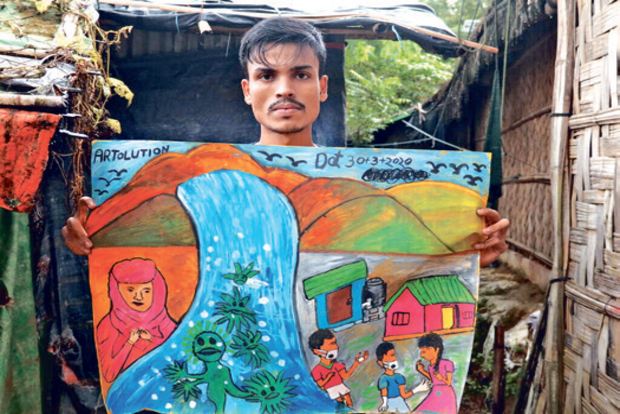Begin typing your search...
Uncovering History: For Rohingya survivors, art bears a witness’ role
Before he fled Myanmar in 2017, a witness to unspeakable horrors in his Rohingya village, Mohammed Nur would produce art in hiding, drawing on napkins and trash with bits of charcoal. Art, poetry readings and a university education were among many aspects of life that were not allowed for Rohingya Muslims like himself.

Chennai
As his village was set ablaze, part of a campaign of mass slaughter, rape and arson by the Myanmar military and mobs from the country’s Buddhist majority, Nur, then 22, escaped with five family members, leaving behind “burning people,” including his beloved uncle. By day, they concealed themselves in holes covered with dirt, traveling at night. A week later they crossed the Naf River, the perilous liquid border between Myanmar and Bangladesh. Along with hundreds of thousands of others, Nur and his family set up new lives in ramshackle tarpaulin and bamboo shacks in Kutupalong, what is now the largest refugee settlement in the world — a fraught and densely packed environment seemingly at odds with art.
Yet in this unlikeliest of places, Nur has finally achieved his long-held goal of becoming an artist. He is one of 25 Rohingya and local Bangladeshi muralists who have earned the nickname “ronger manus” — the colourful people. He and fellow artists, all trauma survivors, are using the power of the paintbrush to create life-affirming — and potentially lifesaving murals — about Covid-19, safe hygiene practices, neonatal care, the dangers of domestic violence and other public health concerns. Folk art with a message, roughly 200 murals adorn everything from latrines and health clinic waiting rooms to “monsoon walls” snaking up hillsides, meant to prevent mudslides in heavy rains.
Muralists like Nur, who in turn teach children, are part of an ambitious initiative by Artolution, a New York-based arts education non-profit working in global crisis zones that include refugee camps in southern Bangladesh where roughly 740,000 Rohingya fled in 2017. The organisation’s mission is to deploy the arts as a humanitarian tool. Its executive director and co-founder, Max Frieder, an intrepid 31-year-old dreadlocked artist and educator, trains refugees within the camps to become muralists and teachers, drawing on and augmenting their own flourishing craft traditions.
The Rohingya, whose culture is based on oral tradition, have high illiteracy rates because of a lack of access to education in rural areas, especially for women. Murals offer a universal language. Placed strategically throughout the camps, they provide refugees the opportunity to shape their harsh and chaotic surroundings with dollops of color and pertinent narratives. A mural in Kutupalong addresses the issue of forced child marriage through a portrait of a young girl in a vibrant red hijab weeping as her husband stands impassively beside her. In another the facade of a women’s community center is covered with a huge eye suggesting the wakefulness of Rohingya mothers fearful of harm once again befalling their children.
A W.H.O. study last year underscored the benefits of the arts to mental and physical health and well-being. Frieder’s work with Rohingya muralists coincides with Artolution programs in the Azraq camp for Syrian refugees in Jordan, and with programs for displaced Venezuelans in Cali, Colombia, led by the group’s chief executive and co-founder, Joel Bergner, an artist. Their efforts are part of a growing international awareness of the positive role of the arts in fostering resilience in public health emergencies — from the Liberian musicians who produced radio hits to inform people about the Ebola virus to comic books and board games addressing H.I.V. and teenage pregnancy in Uganda.
Brown is a journalist with NYT©2020
The New York Times
Visit news.dtnext.in to explore our interactive epaper!
Download the DT Next app for more exciting features!
Click here for iOS
Click here for Android
Next Story



